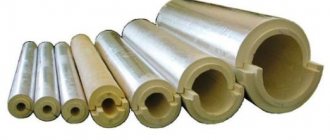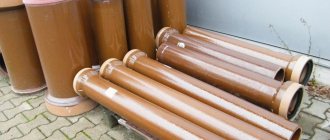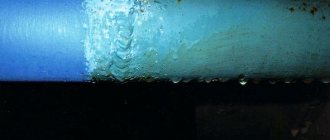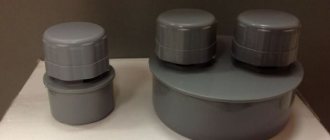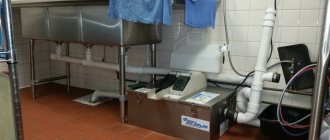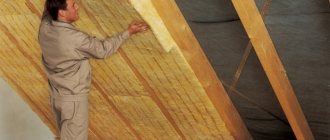Owning a home is the dream of many people. When the opportunity arises, they begin to build the mansion on their own. In the process of its construction, many questions arise. One of the most common is the laying of a sewer in a private house. If available, it provides comfort while living in the house. It allows you to drain wastewater from the dwelling into a special well.
When it comes to sewerage when building a house, many people turn to the services of specialists. Although their work is of high quality and after its completion, the owner receives an effective sewage system, nevertheless, their services are not cheap and require a certain amount of money. Or maybe refuse outside help and do all the work on your own? Moreover, although there are difficult moments here, the task of an independent sewage system is not among the impossible. If you delve into the intricacies of the construction of the sewer network in your home, then all the work can be done with your own hands, you can save a lot and get an effective sewage system.
What do you need to know?
When the owner decides to lay a sewer system in the house, then first of all it is necessary to find out if there is access to the centralized backbone... If such a line passes in your village, then the device of the sewerage system in this case is not very difficult. You just need to find out from specialists:
- which pipes are best suited for draining wastewater and water from the house;
- how to lay pipes correctly;
- how to properly bring the pipes to the manifold.
The greatest difficulty when connecting to a centralized highway is laying pipes on the street. During this work, you have to dig a trench. How deep the trenches are required depends largely on the level of soil freezing. Usually pipes for sewage on the street laid at a depth of 0.5-1 m.
If your house is located far from the sewer main and there is no way to connect to it, then in this case you will have to start working on the device of an autonomous sewer system.
What factors determine the depth of immersion of sewer pipes
It is customary to bury the sewer system in the ground for several reasons:
- the need to hide the pipes from the view of the inhabitants of the house;
- the desire to free up space for planting plants or installing landscaping objects;
- protection of the system from low temperatures.
The assembly of the external sewage system is carried out along the bottom of the trench, the depth of which is determined by various factors:
- the level of soil freezing in winter;
- the presence of permafrost;
- the depth of the soil waters;
- the composition of the soil at the site of the line;
- configuration and composition of the system;
- the size, volume and depth of immersion in the soil of a septic tank or cesspool.
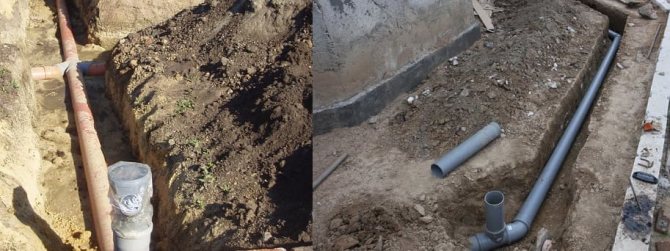
laying of external networks
There are many factors, therefore, in practice, the depth of laying the sewer pipe is usually determined by the most significant of them. For example, in many regions of Russia the soil freezes by 2.5 meters or more, which cannot be ignored during the execution of work. In addition, the composition of the system is an important factor. Usually it is a gravity pipeline, in which all the drains move naturally at a low speed. This means that the potential for liquids to freeze is extremely high and appropriate action must be taken.
Types of sewerage in a private house
First, you need to decide how the sewer system will look like. It can have a different look:
- cesspool;
- septic tank.
Cesspool
Traditionally for the drainage of waste water from the home cesspools were used... Now they are considered a relic of the past. However, they have the right to life, if only because:
- they efficiently handle wastewater disposal;
- construction work is devoid of difficult moments.
If you decide to create a sewage system like a cesspool, then before embarking on the implementation of this idea, you need to learn about the engineering and geological features of the soil in your area.
The easiest option to build a cesspool is make brickwork... It is most reasonable to use red ceramic brick as a material. If you are ready to spend money on attracting special equipment, then you can arrange this structure from concrete rings. When constructing such a pit, the bottom is concreted, and then rings are installed. From above, the structure is covered with a plate with a ventilation hole and an inspection hatch.
Septic tank
In many homes, a septic tank is used as a sewerage system. Its main advantages are:
- simplicity of construction work;
- reliability during operation;
- the ability to install on your own;
- simplicity of work on the device of such a sewerage system.
At present there are several types of septic tanks... There are even three-chambered ones that have a high degree of waste and domestic water purification. And all due to the fact that such systems include a complex of aeration and biofilters.
Common mistakes
It is possible to install the external sewerage system with high quality and in a short time while avoiding the following mistakes:
- Savings on materials. The difference in cost with cheaper counterparts may be less than repairing the system.
- Installation of external sewerage pipes in a short time. Sections of the pipeline must be carefully measured and carefully cut. The angles of inclination must be created exactly according to the project.
- Insufficient placement of drainage pipes. If they become clogged or have a low flow rate, liquid stagnation will occur.
Prices per meter of work on laying an external sewage system start from 270 rubles (when installing non-pressure PVC systems with a diameter of 110 mm). With a pipe size of 500 mm, prices increase to 800 rubles.
Sequencing
Before starting work on the device of an autonomous sewage system in your home, you need to decide on a work plan:
First you need to decide where the cesspool will be located on your site. You should know that the drainage well must be below the level of the house.
It is also important to determine the place where the collector exits the structure. It is necessary to carefully inspect the place where the pipe comes out, taking into account the fact that all waste water from your home will be concentrated at this point. It is necessary to inspect the place of admission in order to make sure in the correct installation of the collector... Distortions and deviations during installation must be absent.
When the site has been examined and important issues have been resolved, you can proceed to drawing up a sewage project.
It must be borne in mind that the external sewerage system must be straightforward. The inner one has many corners and bends, therefore, when working on its laying, all dimensions of pipes and bends should be calculated.
When all the important points have been resolved and all calculations have been completed, you can proceed to the acquisition of the necessary materials.
Next comes the turn for work on the installation of external and internal sewerage systems.
Outer piping diameter
The diameter range of pipe products for external sewerage is 110 - 600 m.In order to correctly choose the diameter of the sewer pipe, it is necessary to take into account the number of plumbing fixtures in the structure and the volume of the discharged waste.
The most common size of the external pipeline is 110 m. In this case, the length of the product can be different: 110x500, 110x1000, 110x2000, etc.
A diameter of 110 mm is usually sufficient for a private house. However, if we are talking about an apartment building, boarding house or recreation center, one should give preference to a size of 160 mm.
Marking on polymer products indicates their outer diameter. For example, a DN 110 pipe has an outer diameter of 110 m and an inner diameter of about 100 mm.
The connection of pipe products with a diameter of 110 m can be carried out both by the socket method and by the soldering method. Socket technology greatly simplifies the installation of the system with your own hands, but in this case, you will need special fittings.
Outdoor sewerage
The internal sewerage system does not differ in its appearance from the one installed in the apartment. But the scope of work for its device will vary significantly.
The time and effort to create it will have to be spent less if the dwelling has old sewerage... In this case, the main work will be associated with the dismantling of old pipes. You can use old sewer pipes. However, it may turn out that you have to redo the entire system as a whole. In this case, it will take a lot of time and effort to create a new autonomous sewage system in the house. The floor will need to be raised.
And if it turns out that the depth of the sewerage is insufficient, then you will have to deepen it. To do this, you will have to dig a hole under the foundation, and then measure the distance from the bottom edge of the foundation to the top. It should be at least 1 m. In this case, the drains transported through the laid collector pipe will not freeze even in the harsh winter.
It is necessary to dig a trench from the outside of the house. directly to the well... It should be deeper than in the house. This is to ensure a constant slope for the pipe. In this case, the drainage water will flow freely into the well.
At the exit from the house, the trench should have a depth of at least 1 meter, and every 10 meters the depth of the trench should decrease by half a meter.
External sewerage
The external part of the local sewerage system for a country house is fundamentally divided into two types.
It:
- Cesspool.
- Biological treatment system.
The cesspool, in turn, is subdivided into a sealed structure and without a bottom.
A cesspool in a private house with your own hands without a bottom is now prohibited for construction due to environmental pollution. This archaic method of disposal is now suitable only for summer cottages, and then provided that the volume of wastewater per day does not exceed 1 cubic meter, the distance from the bottom of the pit to the upper level of groundwater is at least 1 meter, the distance from the pit to the place of drinking water intake is not less 50 m.
An example of a cesspool without a bottom
Advice: if sewage gets into the drinking water intake and people are injured, the culprit may be criminally liable.
The next option: arranging a sewage system in a private house using a sealed cesspool.
Sealed cesspool
The plus, of course, is that you do not need to fool your head in search of a solution to what to do with the sewage. A large sealed tank is dug into the ground, which is periodically pumped out by a sewer truck. Your only task is to ensure that the maximum permissible level of drains is not exceeded.
Advice: Install a float level switch in the pit.
The disadvantage of this solution is the high cost of maintenance. Calling for a flush truck will cost you about $ 30 per visit.The number of visits depends on the volume of the tank, but is usually equal to 2-3 visits per month.
It is not difficult to calculate the minimum volume:
- On average, one person produces about 150 liters of wastewater per day. If the family consists of 4 people - 600 or 0.6 cubic meters.
- This means that with a pit volume of 6 cubic meters, you need to order a car once every 10 days, 12 meters - once every 20 days.
Advice: do not make the depth of the pit more than 3 meters, otherwise the pipe of the sewage machine may not reach the bottom of the pit.
All the distances between objects on the site should be, as in the case of the construction of a pit without a bottom.
Now let's look at how to make a sewage system in a village house in the form of a complete biological wastewater treatment system.
Laying sewer pipes in a trench
The construction of a wastewater drainage system involves the installation of pipes both outside the house and inside. Next, let's talk in detail about how the outer pipes should be laid. Experts in this regard give the following recommendations.
At the bottom of the dug trench, it is necessary pour a layer of ordinary sand... Its thickness should be 15-20 cm. The creation of such a sand cushion will protect the sewer pipes from excessive pressure, even if they are polypropylene pipes. Having laid the pipes on the sand, they will slightly shrink and take a comfortable position. This will eliminate the excessive load on them in the form of the pressure of the backfilled soil.
Another important point is the connection and sealing of joints. A tee must be inserted every 3 m of pipe. Thus, an audit will be equipped, which is the same pipe that goes to the surface of the earth. Revision is necessary so that in the event of a blockage in the pipe, it could be cleaned without any difficulties. Experts do not advise saving on the installation of an audit. The funds spent on the purchase of tees will pay off during the operation of the sewer system. After every four meters, preferably install revision... The outside of the pipe outlet is closed with a special plug.
Installation
Assembly of pipelines is not difficult at all. They start from the point of exit from the house and gradually approach the place of entrance to the septic tank. Sometimes a preliminary rough assembly helps, which makes it possible to clarify how correctly the calculations were made, whether the slope and depth of the sewage system were observed in a private house. Small discrepancies with the calculated values almost always occur, so the ability to make the necessary corrections during the rough assembly is very useful.
The final installation is carried out simultaneously with the insulation and sealing of the joints. Particular attention should be paid to pipe bends and entry / exit points where the potential for frost and blockages is greatest. After the end of the assembly, the system is checked for operability and the presence of leaks. If no problems arise, the trench is buried. From this moment on, the sewerage system is considered to be put into operation.
Internal sewerage
When installing an internal sewage system, many owners of private houses are increasingly using polypropylene pipes. These products have many advantages:
- they are not subject to corrosion;
- have a long service life;
- installation of such pipes is not difficult and affordable for every owner.
Having made a choice in favor of polypropylene pipes when laying an internal sewage system, it is necessary to take into account how many sources of wastewater are available in a private house. If a large number of plumbing fixtures are installed in the dwelling, then in this case it is optimal to use pipes with a diameter of 100 millimeters for laying the internal sewage system.
It should also be taken into account that when leaving the sink, the pipe must have a diameter of 50 mm... Therefore, during the laying of the internal sewage system, pipes of different diameters will have to be joined.However, note that at the moment this is not a big problem, since there are special adapters. Therefore, you can not worry about reliable sealing of joints.
When connecting the pipes to each other, it will be useful to check the quality of the gaskets. They should not be damaged, in this case, leakage at the joints will be excluded.
Risers are also equipped with an audit. Its installation is carried out from the floor at a height of at least one meter. In addition, special exhaust pipes are installed, which should be located above the roof at a distance of 70 cm... Why is such a complex riser design necessary? When a private house is connected to the sewage system, gases and unpleasant odors are inevitable. If the riser has reliable ventilation, then you can get rid of such unpleasant phenomena. Installation of a riser for ventilation of the sewage system ensures the displacement of polluted air. Therefore, spending time and money on its device, you can get rid of the unpleasant odor in your home.
Another important point to be aware of: if the riser is located in an unheated room, then it is necessary to carry out work on its insulation. A special release must be used to connect the riser to an external sewage system. Its diameter should be smaller than that of the pipe on the riser.
The installation of the outlet to the riser in the direction of the movement of polluted water should be carried out at an angle of 90 degrees. In addition, two 135 degree bends must be used to connect the risers. If there is a need for another additional riser, then use an oblique 45 degree tee... And besides this, an additional branch is installed.
It is much easier to arrange an autonomous sewage system in a household if there is one riser and one collector pipe. When laying an external sewage system, it is best to use 150 mm polypropylene pipes.
Sewerage installation
Any sewerage system, regardless of the degree of complexity of its scheme, is divided into two parts. The part that is located in the house is called the inner contour, and the part laid down the street, respectively, is the outer contour.
Sewer internal networks
- They begin the sewerage system in a private house by determining the location of the treatment plant.
Advice! As a rule, the septic tank should be located on the side where the natural slope of the site relief is observed.
- Knowing in which side the septic tank will be located, it will be possible to determine the place where the pipes of the internal networks leave the house. Here you will need to make a hole in the foundation through which the pipe will pass.
- Further, the laying of the sewage system in the house is carried out so that all drains are reduced to the point where the pipe is removed from the foundation.
- The best internal sewerage scheme is the one that provides for the installation of a sewer riser. All pipes leading from the water drain points in the house will be connected to this pipe.
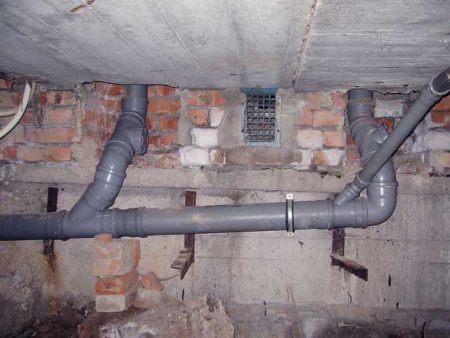

It should be noted that the sewerage wiring in a private house can be either open (that is, with the pipes fastened to the walls using clamps), and hidden (that is, the pipes pass under the floor and in partitions). Both methods have their advantages. The advantages that an open laying of an internal sewage system gives:
- Easy access to pipes during system operation.
- The ability to quickly identify leaks and other defects in the sewer pipeline.
- The ability to quickly disassemble and repair the system without disturbing the decoration in the room.
- Easy access to the installation sites of revisions, necessary to eliminate blockages.
The disadvantages of this method include an unattractive view of the room from an aesthetic point of view, along the walls of which pipes stretch, as well as difficulties with cleaning. After all, you will have to clean out dust and dirt on the pipes themselves and under them.The advantages of laying a sewer in the floor:
- Improvement of the interior design of the premises.
- Decreased audibility when drains pass through pipes.
The disadvantage is the complexity of repairing the system laid in this way.
Advice! If hidden laying of sewage pipelines is planned, then the quality of pipes and fittings should be treated with special attention. And after the system is assembled, do not waste time on conducting hydraulic tests to identify possible assembly defects.
Organization of the drainage from the house
When deciding how to properly lay the sewage system, one cannot ignore the organization of the pipe outlet from the house. Here are the basic requirements for doing this job:


- As a rule, if the construction of the sewage system is planned at the design stage of the house, then a technological hole is left in the foundation in advance through which the pipe will pass. If such a hole has not been made, you will have to punch it in the already finished foundation.
- The angle at which the pipe outlet is organized should not be straight. At the junction of the inner and outer pipes, a pair of 135 degree bends must be installed. This will not only reduce the risk of blockages, but also reduce the degree of pipe wear, and also reduce the noise level during the operation of the sewage system.
- The pipe through the foundation must pass through a metal sleeve, and the diameter of the sleeve must exceed the diameter of the pipe.
Advice! The hole made must be at least 50 mm larger than the pipe diameter.
- After laying the pipe, the space between its outer wall and the inner surface of the sleeve is filled with a soft insulation material. Such precautions help reduce the risk of freezing of the sewer at the outlet, and also protect the pipe from deformation if shrinkage occurs at home.
The difficult moment is the laying of the sewage system under the foundation. When working with slab foundations, it will be difficult to punch a hole in the concrete to route the pipes under the slab. To perform this work, the directional drilling method is used, during which a well is performed for laying pipes, it goes to the lower edge of the foundation block.
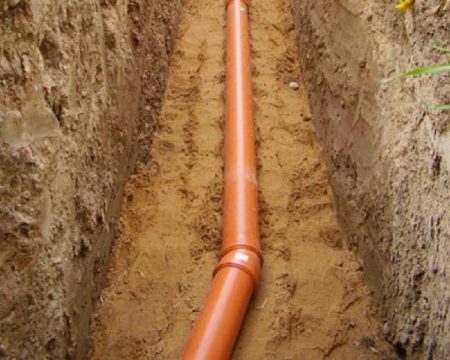

Sewer external networks
As a rule, the laying of sewer networks along the street is carried out using PVC or polypropylene pipes. The peculiarity of pipes intended for external networks is orange color.
If a high load is expected on the pipes (deep burial, the passage of the pipeline under the carriageway), then two-layer pipes with a corrugated outer surface, made of polyethylene or polypropylene, should be chosen. Here are the basic rules for laying sewers:
- The pipes are laid in trenches, which are previously dug out by an excavator or manually.
- The width of the trenches should be such that, after laying the pipe, the installer can freely carry out work on joining the pipes, standing at the bottom of the trench. The minimum distance between the inner slope of the trench and a pipe with a cross section of not more than 200 mm is 20 cm. When using pipes of larger diameter, this distance should be even greater.
- The trenches are dug in such a way as to ensure the optimal slope of the pipes. At the same time, the depth of the sewer installation is not standardized, but is determined based on local conditions.
- The bottom of the prepared trenches is carefully compacted; there should be no frozen areas, large stones or other solid inclusions on it. The stones must be removed, and the excavation site covered with soil and compacted.
- The execution of a cushion of sand under the pipes is mandatory for all types of soil.
- Pipes are laid in prepared trenches along the entire length of the pipeline. Pipe connections begin to be made from the place where the sewer is removed from the house.
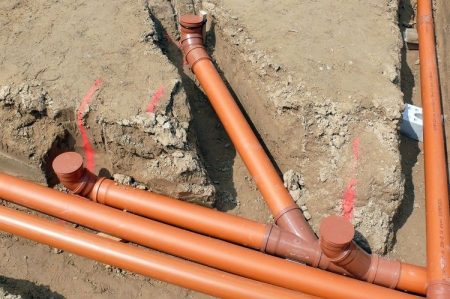

- Silicone grease should be used to connect the pipes, but liquid soap can also be used.The lubricant is applied to the smooth end of the pipe, which is then inserted into the socket with a rubber collar.
- If it is necessary to turn the pipeline, smooth bends are used.
- The external pipeline is connected to the septic tank chamber using a rubber seal, that is, the connection should not be rigid.
- Backfilling of pipes is carried out first with sand, and then with soil previously removed from the trench.
Advice! Trenchless sewerage installation can be a good solution. Using such progressive methods, the owners laid pipelines without damaging green spaces and buildings. But for the sewage system to be built in this way, high-tech equipment will be required, the operation of which will be expensive.
So, the laying of sewer networks when arranging a country house may well be carried out independently. Before performing the work, a novice master should carefully study the requirements of building and sanitary standards, since only if they are observed, the system will work effectively without harming the environment.
Choice of equipment
One of the most critical operations in the process of performing preparatory work is the choice of the material of manufacture and the technical characteristics of the pipeline. If earlier the unconditional leadership in the market belonged to cast iron pipes, then in recent years they have partially yielded their positions to plastic (PVC) products. The debate about the best material continues, as each one provides the user with specific benefits. The advantages of cast iron pipes include:
- high mechanical strength;
- durability and reliability, especially when applying protective coatings;
- good sound insulation and thermal insulation;
- ease of creation of systems with high throughput.


And here are the main advantages of plastic pipes compared to cast iron:
- lower price (in most cases);
- resistance to corrosion, chemicals;
- low weight, which facilitates transportation and installation;
- no need for complex locksmith and welding work.


Therefore, when choosing a material for each specific pipeline, it is necessary to take into account such operational characteristics as permanent and temporary loads on the pipeline from the external environment and flow rate. In addition to the choice of pipes, you need to decide on the configuration and type of additional elements. In any case, you will need adapters, turns, fastening mechanisms.


Particular attention will have to be paid to the choice of equipment for an autonomous external sewage system. You will have to choose reliable filtering and drainage mechanisms (for example, a special well), excluding the possibility of contamination of groundwater.
The most important element of the design will be a septic tank - a sump. It is necessary to select its volume in accordance with the intensity of the sewer discharges, averaged - at the rate of 1 cubic meter of the capacity of one tenant.
The installation site of the septic tank should not only correspond to the route of the highway, but also ensure the convenience of connecting the sewage system, since the contents of the septic tank should be pumped out at least once every two years. In this case, the permissible distance from the outer walls of the house is at least 9 meters, and the minimum depth is 1.5 meters. In areas where deep soil freezing is possible, the depth index is additionally adjusted.



